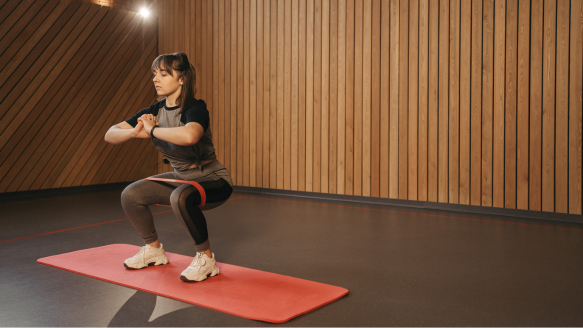There are more exercises but consulting a physiotherapist who understands your pelvic health better will accelerate your wellness and health as they will tailor them to your needs and provide ones that are more essential in your treatment.
What Does Pelvic Floor Physiotherapy Include?
Pelvic floor physiotherapy exercises frequently consist of a combination of body movement exercises, manual remedy alternatives, daily life habit modifications, and education on the core issue so that the patient can manage his condition.
The aim isn’t always to strengthen the pelvic floor but to address the underlying issue or cause of the disorder, thus creating prolonged pain management. Physiotherapists create combinations of treatments based on the need. They include:
Exercise Programs: A physiotherapist will expand a customized exercise plan based on your particular needs, which might also encompass strengthening activities, breathing exercises, stretches, and rest techniques.
Manual Therapy: Some physiotherapists may use hands-on techniques, to help release tension in the pelvic muscles and improve movement.
Biofeedback: For this technique, they use sensors to monitor one’s pelvic floor muscle activity and accordingly plan their treatment.
Education and Lifestyle Advice: They educate patients on proper posture, safe lifting techniques, and advice on activities to avoid that may worsen symptoms. Pelvic floor health is an important aspect of fitness and well-being that many of us often forget. Pelvic Floor consists of muscular tissues that assist vital organs together with the bladder, bowel, and uterus in ladies.
When these tissues weaken, they cause health issues like:
- Stress and Urge Incontinence
- Pelvic Organ Prolapse
- Sacroiliac Joint dysfunction
- Constipation
- Pelvic Pain
- Painful Intercourse
- Pregnancy Discomfort
One can improve their Pelvic health through pelvic floor physiotherapy exercises which aim to boost, tone, and heal these muscles, restoring their functionality and strength.
What Does Pelvic Floor Physiotherapy Do?
Pelvic floor physiotherapy exercises focus on strengthening, relaxing, and improving overall health of Pelvic muscles. These muscle organizations are essential in controlling urination, supporting sexual fitness, stabilizing vital organs supported by it, and much more.
Physiotherapists diagnose underlying issues and also determine your pelvic damage score to tailor the exercises to your needs thus creating a treatment plan to improve your overall Pelvic Floor health.
In addition to strengthening, pelvic floor physiotherapy exercises also help to improve bladder and bowel management, reduce chances of pelvic organ prolapse, relieve signs and symptoms of pelvic discomfort or pain, alleviate pain during intercourse, enhance posture/balance, and improve overall pelvic health.
Whether you are experiencing pelvic pain during or post-pregnancy, after surgery or experiencing age-related health weakening, pelvic floor physiotherapy treatments can significantly improve your overall well-being and create a positive impact on your daily life.
Who Needs Pelvic Floor Physiotherapy?
Targeted Pelvic floor physiotherapy treatments can provide significant benefits for women, helping them address and manage various issues effectively
Signs that one may need pelvic floor physiotherapy:
- You are going to be, you are, you were Pregnant
- You experience hip pain or pain around the Pelvic area
- You have weak Pelvic Muscles
- You just had surgery
- You have pain during intercourse
- You have painful Period
- You have difficulty making a bowel movement
- You experience lower back pain or abdominal muscle spasms
- You have pain that runs down your legs from your lower back
- Leaks even during general activities like coughing, sneezing, or exercising or difficulty controlling your bladder
Let’s understand some more conditions that one might experience due to their weak pelvic floor health:

- Pelvic Organ Prolapse: A medical condition when the pelvic organs drop into the vaginal area due to weak pelvic muscles or tissues.
- Postpartum pelvic pain or weakness: Women recovering from childbirth can benefit considerably from pelvic floor therapy to regain muscle strength and function.
- Post-Surgery Pain: For surgeries involving the pelvic floor or reproductive system (e.g. hysterectomy, C-section, pelvic organ prolapse repair, etc), pelvic floor muscle training (PFMT) or rehabilitation is crucial. It helps to restore the strength and function of pelvic floor muscles providing them the support needed and also helps to prevent postoperative complications
Pelvic physiotherapists tailor exercises after a comprehensive diagnosis of the root cause of the symptoms and conditions experienced by the patient and may guide them to perform targeted exercises like kegels, heel slides or diaphragmatic breathing and targeted treatments like biofeedback, manual therapy, etc. to enhance patient’s pelvic stability.
Key Pelvic Floor Physiotherapy Exercises
There are several key pelvic floor physiotherapy exercises that concentrate on the pelvic floor muscle, such as:
Bridge Pose

This workout not only strengthens the pelvic floor but also engages the glutes and middle.
Deep Breathing with Pelvic Floor Engagement

This exercise prompts the improvement of pelvic floor health in the aspect of the diaphragm.
Squats

Squats are extremely good for pelvic floor fitness and it even works well on the legs and glutes.
Bird-Dog

This body-center balance exercise enhances pelvic floor coordination and stability.
How Pelvic Floor Physiotherapy Can Benefit You?
Incorporating Pelvic floor physiotherapy exercises into your every day can offer numerous benefits, such as improved bladder and bowel control, strengthening the muscular tissues, and much more.
Some of the benefits are:
Better Sexual Health: Strong pelvic floor muscle tissues can enhance sexual delight and reduce pain during intercourse.
Prevention of Pelvic Organ Prolapse: For ladies, targeted strengthening exercises can save them or help them manage prolapse, in which the bladder, uterus or rectum drops into the vaginal area. This is a very painful condition for them.
Improved Posture and Stability: A healthy pelvic floor allows higher posture and core energy, decreasing the chances of pain and discomfort.
In addition to these treatments, there are many other popular pelvic floor physical activities that promote wellness and help one to maintain their fitness.
Adding Pelvic Floor Exercises into Your Routine
Adding pelvic floor exercises or habits that help in wellness to your daily routine doesn’t require extra effort or time. They can be performed in diverse positions (sitting, lying down, or repute) and may be completed discreetly, making them easy to incorporate into everyday life. For example: One can do Bridge Pose while watching TV or include squats in everyday workouts. These exercises need to be done regularly at least thrice a day for better results or pain management. Consistency is fundamental to see long-term advantages, so try to strictly follow these routines and exercise your way to better pelvic floor health.
Pelvic floor physiotherapy exercise is important for your overall health and ignoring it can lead to issues that may affect your daily life. Don’t wait and start caring for your pelvic floor health today. If you are experiencing any symptoms don’t try to treat yourself, consult PhysioRehab Group for comprehensive diagnosis and treatment because we specialize in treating you the right way.


Recent Comments